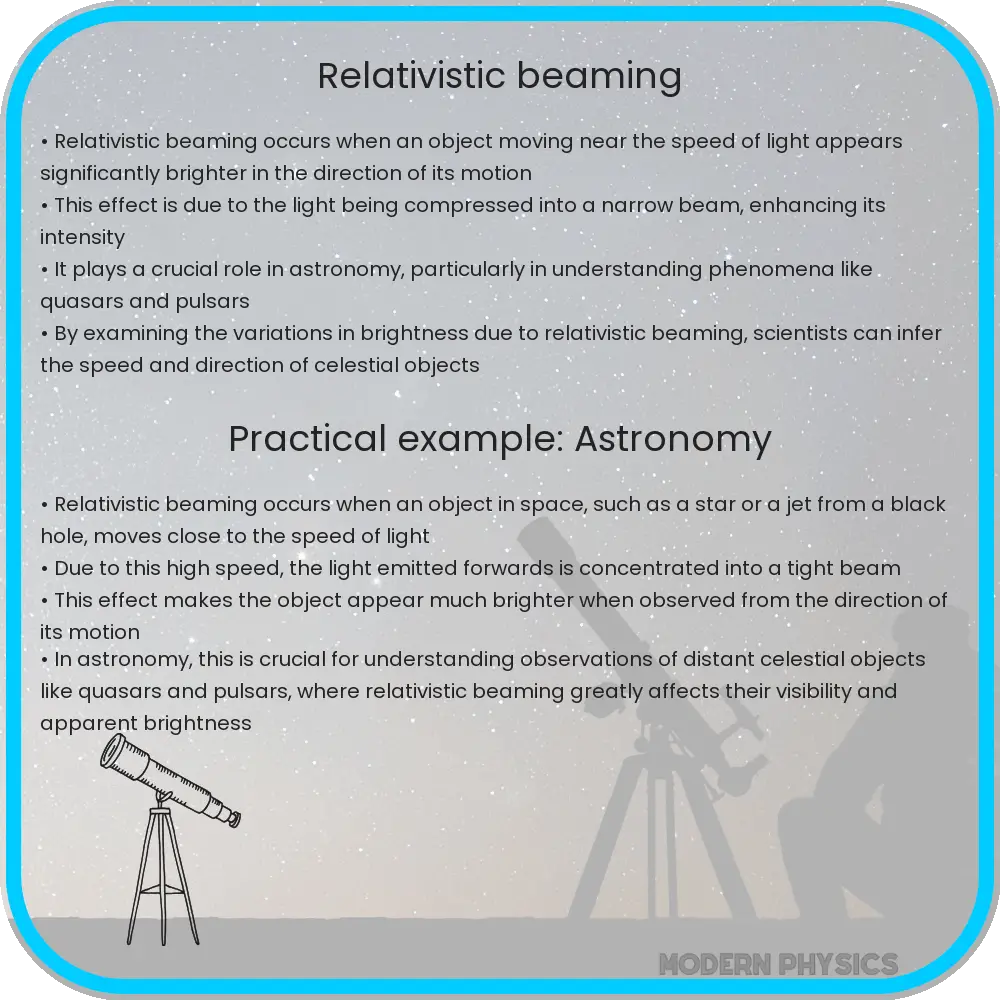Explore the intriguing world of relativistic beaming, where speed and perception merge in the realm of astrophysics and cosmology.

Understanding Relativistic Beaming: The Fascinating Intersection of Speed and Perception
Relativistic beaming, also known as Doppler beaming, is a phenomenon in astrophysics that occurs when an object moves close to the speed of light. It plays a crucial role in our understanding of various astronomical objects and events. This article delves into the basics of relativistic beaming, exploring how velocity and the speed of light intertwine to alter our perception of celestial objects.
What is Relativistic Beaming?
Relativistic beaming is an effect of the special theory of relativity, formulated by Albert Einstein. It refers to the apparent changes in the brightness and position of an object moving at a significant fraction of the speed of light. As objects move rapidly towards or away from an observer, the light they emit is affected in unique ways, influencing how we perceive them from Earth.
The Science Behind the Effect
The phenomenon is primarily governed by two principles: the Doppler effect and relativistic aberration. The Doppler effect is commonly experienced with sound waves; a notable example is the change in pitch of a siren as an ambulance approaches and then recedes. In the context of light, this effect causes the wavelength of electromagnetic radiation to shift depending on the relative motion of the source and the observer. When an object moves towards us, its light shifts to shorter wavelengths (blue shift), and when it moves away, to longer wavelengths (red shift).
Relativistic aberration, on the other hand, refers to the apparent change in direction of light due to the motion of the source relative to the observer. This effect becomes more pronounced as the velocity of the light-emitting object approaches the speed of light. The combined impact of the Doppler effect and relativistic aberration leads to an increase in the observed brightness of the object in the direction of its motion. This intensification of light is what we refer to as relativistic beaming.
Examples of relativistic beaming are observed in various astrophysical contexts, such as in jets emitted by black holes and neutron stars. These jets, composed of plasma, travel at nearly the speed of light, making them ideal candidates to observe and study this remarkable phenomenon.
Understanding relativistic beaming not only enriches our knowledge of high-speed celestial phenomena but also provides crucial insights into the fundamental principles of physics. By studying how light is affected by extreme velocities, scientists gain a deeper comprehension of the universe’s workings at its most extreme scales.
Applications and Implications of Relativistic Beaming
The study of relativistic beaming has significant implications in astrophysics and cosmology. One of its most notable applications is in the field of active galactic nuclei (AGN). AGNs are supermassive black holes at the centers of galaxies that accrete matter at high rates, producing enormous amounts of energy. The jets emitted by AGNs often exhibit relativistic beaming, making them appear much brighter than they would if the jet were stationary relative to the observer. This effect aids astronomers in identifying and studying these distant objects.
Another application is in the study of gamma-ray bursts (GRBs), the universe’s most energetic explosions. These bursts are thought to emit highly collimated jets that travel at relativistic speeds. Relativistic beaming in GRBs can greatly amplify their brightness, making them observable across vast cosmic distances. This has helped astronomers to better understand the extreme conditions present during these events.
Additionally, relativistic beaming is a critical factor in the observation and analysis of pulsars. Pulsars are rapidly rotating neutron stars that emit beams of electromagnetic radiation. Due to their high rotational speeds, the radiation emitted from pulsars experiences relativistic beaming, affecting how we observe their pulses from Earth.
Challenges in Observing Relativistic Beaming
Observing and interpreting relativistic beaming effects poses several challenges. The extreme velocities involved mean that small changes in the direction of motion can lead to significant changes in the observed properties of the object. Additionally, distinguishing the effects of relativistic beaming from other astrophysical phenomena requires precise measurements and sophisticated theoretical models.
Conclusion
Relativistic beaming provides a fascinating window into the behavior of light and matter under extreme conditions. It not only enhances our understanding of high-velocity celestial objects but also serves as a critical test for the theories of special relativity and astrophysics. As observational techniques continue to advance, our ability to study and comprehend the effects of relativistic beaming will undoubtedly grow, offering deeper insights into the dynamic and enigmatic universe in which we live.
